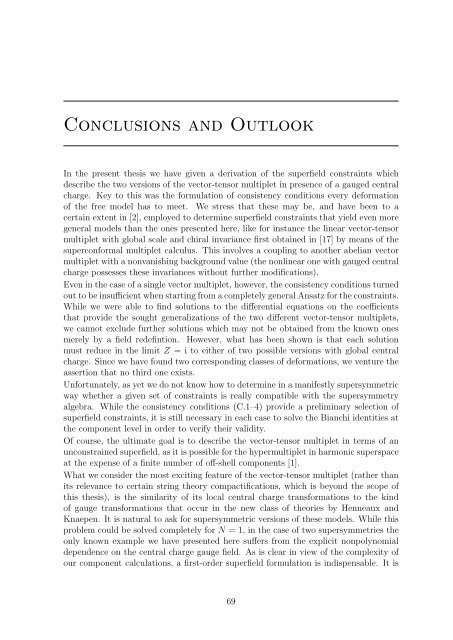N=2 Supersymmetric Gauge Theories with Nonpolynomial Interactions
N=2 Supersymmetric Gauge Theories with Nonpolynomial Interactions
N=2 Supersymmetric Gauge Theories with Nonpolynomial Interactions
You also want an ePaper? Increase the reach of your titles
YUMPU automatically turns print PDFs into web optimized ePapers that Google loves.
Conclusions and Outlook<br />
In the present thesis we have given a derivation of the superfield constraints which<br />
describe the two versions of the vector-tensor multiplet in presence of a gauged central<br />
charge. Key to this was the formulation of consistency conditions every deformation<br />
of the free model has to meet. We stress that these may be, and have been to a<br />
certain extent in [2], employed to determine superfield constraints that yield even more<br />
general models than the ones presented here, like for instance the linear vector-tensor<br />
multiplet <strong>with</strong> global scale and chiral invariance first obtained in [17] by means of the<br />
superconformal multiplet calculus. This involves a coupling to another abelian vector<br />
multiplet <strong>with</strong> a nonvanishing background value (the nonlinear one <strong>with</strong> gauged central<br />
charge possesses these invariances <strong>with</strong>out further modifications).<br />
Even in the case of a single vector multiplet, however, the consistency conditions turned<br />
out to be insufficient when starting from a completely general Ansatz for the constraints.<br />
While we were able to find solutions to the differential equations on the coefficients<br />
that provide the sought generalizations of the two different vector-tensor multiplets,<br />
we cannot exclude further solutions which may not be obtained from the known ones<br />
merely by a field redefintion. However, what has been shown is that each solution<br />
must reduce in the limit Z = i to either of two possible versions <strong>with</strong> global central<br />
charge. Since we have found two corresponding classes of deformations, we venture the<br />
assertion that no third one exists.<br />
Unfortunately, as yet we do not know how to determine in a manifestly supersymmetric<br />
way whether a given set of constraints is really compatible <strong>with</strong> the supersymmetry<br />
algebra. While the consistency conditions (C.1–4) provide a preliminary selection of<br />
superfield constraints, it is still necessary in each case to solve the Bianchi identities at<br />
the component level in order to verify their validity.<br />
Of course, the ultimate goal is to describe the vector-tensor multiplet in terms of an<br />
unconstrained superfield, as it is possible for the hypermultiplet in harmonic superspace<br />
at the expense of a finite number of off-shell components [1].<br />
What we consider the most exciting feature of the vector-tensor multiplet (rather than<br />
its relevance to certain string theory compactifications, which is beyond the scope of<br />
this thesis), is the similarity of its local central charge transformations to the kind<br />
of gauge transformations that occur in the new class of theories by Henneaux and<br />
Knaepen. It is natural to ask for supersymmetric versions of these models. While this<br />
problem could be solved completely for N = 1, in the case of two supersymmetries the<br />
only known example we have presented here suffers from the explicit nonpolynomial<br />
dependence on the central charge gauge field. As is clear in view of the complexity of<br />
our component calculations, a first-order superfield formulation is indispensable. It is<br />
69

















